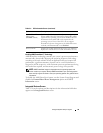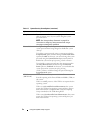
Using the System Setup Program 47
Memory Information Screen
Table 2-4 lists the descriptions for the information fields that appear on the
Memory Information screen.
Keyboard
NumLock
(
On
default)
Determines whether your system starts up with the NumLock
mode activated on 101- or 102-key keyboards (does not apply
to 84-key keyboards).
Report Keyboard
Errors
(
Report
default)
Enables or disables reporting of keyboard errors during the
POST. Select Report for host systems that have keyboards
attached. Select Do Not Report to suppress all error messages
relating to the keyboard or keyboard controller during POST.
This setting does not affect the operation of the keyboard
itself if a keyboard is attached to the system.
Table 2-3. Memory Information Screen
Option Description
System Memory Size Displays the amount of system memory.
System Memory Type Displays the type of system memory.
System Memory Speed Displays the system memory speed.
Video Memory Displays the amount of video memory.
System Memory
Testing
This option determines whether system memory tests are
run at system boot. Options are Enabled and Disabled.
Redundant Memory
(Disabled default)
Enables or disables the redundant memory feature.
Redundant memory feature is disabled if the Node
Interleaving field is enabled.
Node Interleaving
(Disabled default)
If this field is enabled, memory interleaving is supported
if a symmetric memory configuration is installed. If this
field is set to Disabled, the system can support Non-
Uniform Memory architecture (NUMA) (asymmetric)
memory configurations.
NOTE: The Node Interleaving field must be set to Disabled
when using the redundant memory feature.
Table 2-2. System Setup Program Options (continued)
Option Description


















